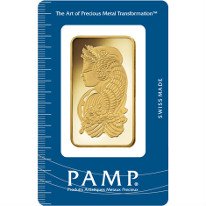Free Gold Price Widget For Your Website
This feature is only supported in the desktop browsers. Please visit this page in your desktop browser to retrieve the widget.
Share live gold prices with your website followers or on your blog, using our free gold price widget. To get started, please select one of the size dimensions from the drop-down menu below, and copy the code from the Widget Code text box and paste it into the desired position in your page. If you have any trouble, please contact us at support@jmbullion.com.
Widget Preview
Widget Code
Gold Prices in Brazilian Real
Although when many think of dollars when it comes to buying or selling gold, the yellow metal can be transacted in any currency, and the currency used is likely determined by location. If you live in Brazil, for example, you would likely use the local currency, or Brazilian Real, to trade gold.
The Brazilian Real can be divided into 100 centavos, or cents, and its sign is R$. The present day real was introduced back in 1994 as part of the Plano Real. The currency was introduced at a time when inflation had run rampant for several decades, and the country’s leadership had decided that massive monetary reforms were necessary.
The real was introduced with a value of 1:1 versus the dollar. After its introduction, the real reached its highest value versus the dollar ever, at about $1.20. Today, a dollar is worth just over 3.11 real.
Brazil today has one of the largest economies in the entire world, and it is the largest Portuguese-speaking country in the world. The country minted its first gold coins in the 1750s, and in 1790 the real became the colony’s official currency. Gold coin production continued into the 20th century, and gold commemorative coins are still produced today. Recently, a commemorative gold coin was produced paying homage to Christ the Redeemer and Olympic wrestling.
Gold Pricing in Brazilian Real
Gold can be bought or sold using Brazilian Real by the ounce, gram or kilo. In the U.S., you will typically not see gold prices quoted in this currency. In Brazil however, the price of gold is likely quoted in real and may also be quoted in dollars or other key currencies.
The gold price in this currency can potentially be affected by numerous factors. Some of the possible issues that can cause changes in the price of gold include:
- Central bank activity
- Geopolitical issues
- Investment demand
- Risk appetite or aversion
- Currency markets
- Inflation or deflation
The price of gold in Brazilian Real is determined in the same fashion as gold prices in other regions and in other currencies. Prices may be dictated by a pricing mechanism such as the LBMA gold price auction held twice each day. (Prices are set in U.S. Dollars per fine troy ounce.) Prices are, however, also available in some other currencies.
Gold prices also follow key gold futures contract prices, using the most heavily traded near-term gold futures contract.
Regardless of what currency you may be looking at, the price of gold can have periods of quiet and little price movement as well as periods of extreme price movement and market volatility.
Brazilian Mints and Products
The Casa Da Moeda do Brasil is the Brazilian Mint. This mint was established back in 1694 and is owned by the Brazilian Government. The mint is located in a western suburb of Rio de Janeiro.
The mint produces not only circulating coinage and banknotes, but also makes medals. The Brazilian Mint produced the medals for the 2016 Summer Olympics in Rio.
Brazil has produced some gold coins that may be interesting to gold investors and coin collectors.
The Brazil 10,000 REIS gold coin (1851-1889) can make a good addition to any coin collection. These gold coins were minted at various Brazilian mints and contain .2643 ounces of gold.
These coins were previously used in regular commerce, and feature a historic design. The coin’s obverse features the profile portrait of King Pedro II, while the reverse features the Imperial Brazilian coat of arms.
A 20,000 REIS gold coin was also produced during the same years, but this coin contains .5286 ounces of gold.
The 1972 Brazil 300 Cruzeiros Gold Coin is another great example of a collectable Brazilian gold coin. This coin contains .4925 ounces of gold and celebrates the 150th anniversary of independence.
Brazil’s population and economy could potentially grow in the future, and the country is a large exporter of coffee, soybeans, beef and other products. As the nation’s population grows and as further investment is made in Brazil, demand for gold and other precious metals could potentially rise.
World Gold Prices
- Arab Emirates Gold Price
- Australia Gold Price
- Brazil Gold Price
- Canada Gold Price
- Chile Gold Price
- China Gold Price
- Czech Republic Gold Price
- Denmark Gold Price
- Europe Gold Price
- Hong Kong Gold Price
- Hungary Gold Price
- India Gold Price
- Indonesia Gold Price
- Israel Gold Price
- Japan Gold Price
- Malaysia Gold Price
- Mexico Gold Price
- New Zealand Gold Price
- Norway Gold Price
- Pakistan Gold Price
- Philippines Gold Price
- Poland Gold Price
- Russia Gold Price
- Singapore Gold Price
- South Africa Gold Price
- South Korea Gold Price
- Sweden Gold Price
- Switzerland Gold Price
- Taiwan Gold Price
- Thailand Gold Price
- Turkey Gold Price
- United Kingdom Gold Price
- United States Gold Price










